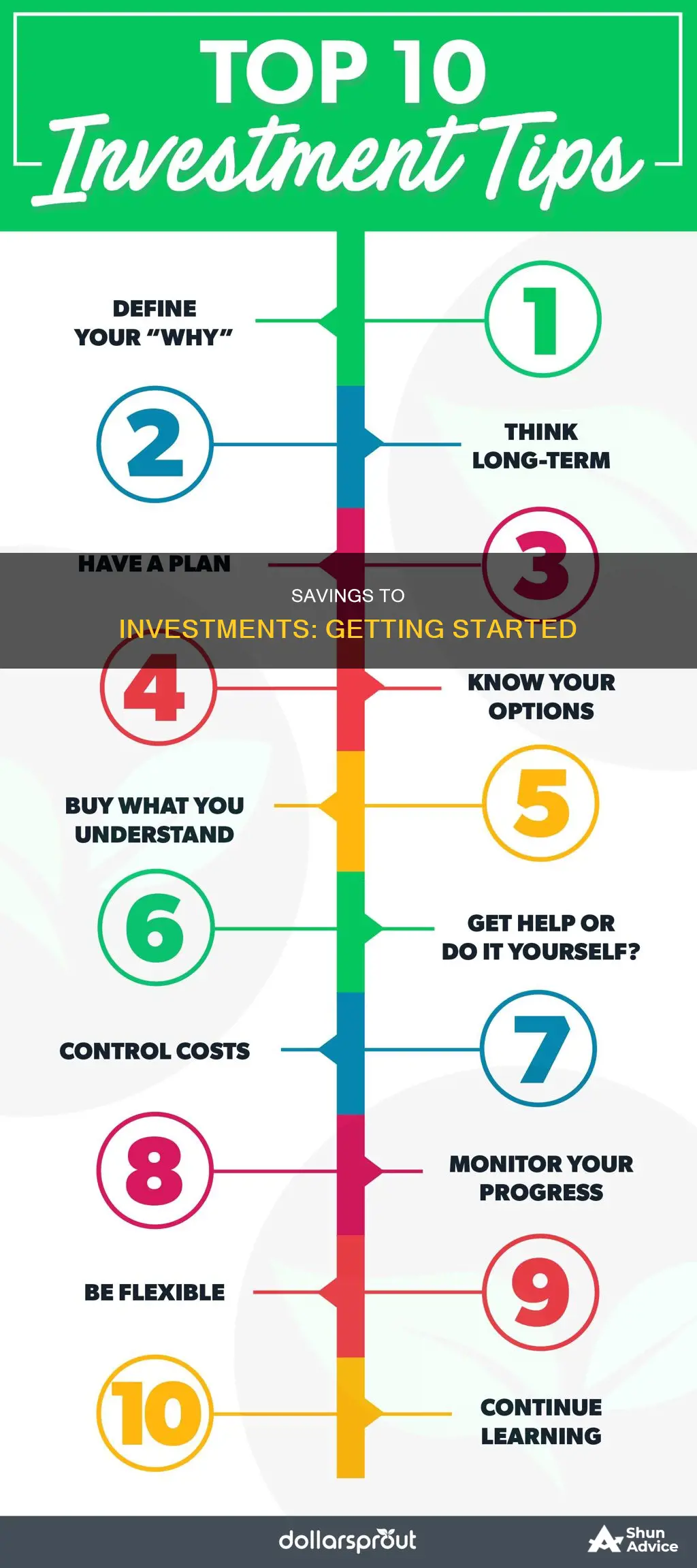
Investing your savings is a great way to build wealth over time. However, it can be intimidating for beginners to start investing. Here are some steps to help you get started:
- Determine your budget and risk tolerance: Before investing, it is important to understand your financial situation and how much risk you are willing to take. Ask yourself if you are willing to take on more risk for potentially higher returns, or if your priority is to avoid losing money.
- Identify your investing style: Decide if you want to be an active investor, who actively researches and manages their investments, or a passive investor, who prefers a more hands-off approach.
- Choose an investment account: Open an investment account based on your goals. If you are investing for retirement, consider a 401(k) or an Individual Retirement Account (IRA). For other goals, a taxable brokerage account may be more suitable.
- Select your investments: Common investment options include stocks, bonds, mutual funds, exchange-traded funds (ETFs), and real estate. Diversify your portfolio by spreading your money across different asset classes to minimise risk.
- Start early: Compound interest can help your investments grow over time, so it is beneficial to start investing as early as possible, even with a small amount of money.
| Characteristics | Values |
|---|---|
| When to start investing | As early as possible |
| How much to invest | Depends on your financial situation, investment goal and time horizon |
| Type of investment account | Taxable brokerage account or tax-advantaged account like an IRA |
| Investment strategy | Based on saving goals, amount being invested and time horizon |
| Investment options | Stocks, bonds, funds, real estate |
What You'll Learn

Determine your risk tolerance
When it comes to investing, it's important to understand your risk tolerance, or how much financial risk you're willing to take. All investments involve some degree of risk, and knowing your risk tolerance will help you plan your investment portfolio.
Your risk tolerance is influenced by various factors, including your age, investment goals, income, net worth, and investment experience. Younger investors with a longer time horizon are generally considered more risk-tolerant and may be more inclined to invest in stocks and stock funds. However, it's important to note that age is not the sole determining factor, as people are living longer and can remain aggressive investors well into their later years.
Your investment goals also play a crucial role in determining your risk tolerance. If you have a financial goal with a long time horizon, you may be willing to take on more risk to achieve potentially higher returns. In contrast, if you have short-term financial goals, lower-risk investments such as cash, savings accounts, or bonds may be more appropriate.
Your income and net worth are other important considerations. Investors with higher incomes, more liquid capital, and a higher net worth may have a greater risk tolerance since they can afford to take on more risk without significantly impacting their financial stability.
Additionally, your investment experience can influence your risk tolerance. If you are new to investing, it's generally advisable to proceed with caution and gain some experience before taking on more substantial risks.
It's worth noting that risk tolerance assessments and questionnaires are readily available online, which can help you better understand your risk tolerance and design a suitable investment portfolio.
The Apple of Your Eye: Navigating the World of Investment Trading
You may want to see also

Choose your investments
The best investments for you will depend on your risk tolerance, financial goals, and time horizon. Here are some common types of investments to consider:
- Stocks: Stocks are individual shares (pieces of ownership) of companies you believe will increase in value. Stocks are considered riskier than bonds but tend to offer higher returns. You can purchase stocks individually or through funds such as mutual funds or exchange-traded funds (ETFs).
- Bonds: Bonds are fixed-income investments where you lend money to a company or government entity, which agrees to pay you back with interest over a set period. Bonds are considered less risky than stocks but typically offer lower returns.
- Mutual Funds: Mutual funds are investment funds that pool investor money to purchase a diverse collection of stocks, bonds, or other investments. Mutual funds can be actively managed by a professional or follow a specific stock market index.
- Exchange-Traded Funds (ETFs): ETFs are similar to mutual funds but trade on an exchange like a stock and can be bought and sold throughout the day. ETFs tend to have lower fees than actively managed mutual funds.
- Real Estate: Real estate investing can provide diversification outside of the traditional mix of stocks and bonds. You can invest in physical properties or through real estate investment trusts (REITs) or online real estate investing platforms.
- Robo-advisors: Robo-advisors use computer algorithms to build and manage a portfolio based on your risk tolerance and financial goals. They offer a hands-off approach to investing and typically invest in low-cost ETFs and index funds.
When choosing your investments, it's important to consider your risk tolerance and financial goals. If you have a high-risk tolerance and a long time horizon, you may want to invest primarily in stocks or stock funds. If you have a low-risk tolerance, you may want to consider a portfolio with more bonds. Diversification is also key to reducing risk, so be sure to spread your investments across different asset classes and individual investments.
Cola-Cola Investors: Who's Involved?
You may want to see also

Open a brokerage account
Opening a brokerage account is a great way to start investing your savings. Brokerage accounts are arrangements between you and a licensed brokerage firm. Once your account is set up, you can deposit funds and place investment orders, and the transactions will be carried out on your behalf.
Identify your financial goals and risk tolerance:
Before opening a brokerage account, it is important to understand your financial goals and how much risk you are willing to take. Ask yourself: What are you investing for? Do you want to invest for retirement, education, or another financial goal? Are you comfortable taking on more risk for potentially higher returns, or is preserving your capital more important?
Choose the type of brokerage account:
There are two main types of brokerage accounts:
- Margin account: This type of account allows you to borrow against your eligible securities. It can be useful when you need to buy more securities or want to take advantage of timely market opportunities. However, margin borrowing comes with risks and may not be suitable for everyone.
- Cash account: This type of account only allows you to use the cash you have deposited to buy stocks, bonds, or other investments. It presents less market risk as you are only investing your own assets, but it can be limiting if you need to act quickly on opportunities or emergencies.
Select a brokerage firm:
When choosing a brokerage firm, consider factors such as the firm's reputation, the range of investment options available, fees and commissions, customer support, and the quality of their trading platforms and tools. Reputable firms like Charles Schwab, Fidelity, and Merrill Edge are popular choices.
Gather the required information and documents:
To open a brokerage account, you will typically need to provide personal information such as your name, contact details, Social Security number, and employment details. You may also need to provide information about any assets or cash you plan to transfer to the new account.
Complete the account opening process:
Follow the brokerage firm's instructions to open your account. This usually involves filling out an online application form, providing the required documentation, and setting up your login credentials. Some firms may also require you to verify your identity and indicate how you will fund the account.
Fund your brokerage account:
Once your account is open, you will need to deposit funds into it to start investing. You can typically fund your account through electronic funds transfer, wire transfer, or check deposit. Some firms may offer additional funding options, so be sure to review their instructions carefully.
Remember to do your research, understand the risks involved, and only invest what you can afford to lose. Happy investing!
China's Investment in Mexico: A Strategic Alliance?
You may want to see also

Set up automatic contributions
Setting up automatic contributions is a great way to make investing a seamless part of your life. Here's how to do it:
Decide on a contribution percentage
Determine what percentage of your salary you can comfortably contribute to your investments. It's recommended that you invest a percentage rather than a fixed dollar amount. This way, as your salary increases, your contributions will also rise. Most experts recommend investing 10% to 20% of your salary. However, it's important to ensure you have an emergency fund of at least three to six months' worth of living expenses before investing.
Choose your account type
You can select from various account types, including a workplace retirement account, a taxable brokerage account, or an individual retirement account (IRA). If your employer offers a 401(k) plan, it's advisable to take advantage of it, especially if they provide matching contributions, which gives you free money for retirement. IRAs, such as traditional or Roth IRAs, are also a popular option, offering different tax benefits.
Select your investments
When it comes to selecting investments, most experts recommend low-cost index funds or exchange-traded funds (ETFs) that track market indices. These options provide an efficient and affordable way to diversify your portfolio. You can also explore other investment choices, such as stocks, bonds, or mutual funds, ensuring they align with your risk tolerance and financial goals.
Set up automatic transfers
Almost all online brokerage platforms offer the option to set up automated transfers. Decide on the frequency of transfers (weekly, bi-weekly, or monthly) and the amount you wish to contribute. This step ensures that investing becomes a consistent and hassle-free part of your financial routine.
Explore additional options
In addition to the steps above, there are other ways to automate your investments. You can consider using a robo-advisor, which uses algorithms to create and manage a diversified portfolio based on your risk tolerance and goals. Micro-investing apps are another option, allowing you to round up your everyday purchases to the nearest dollar and invest the spare change. These apps provide a convenient way to start investing with small amounts, but be aware of their relatively high fees.
XRP Investors: How Many?
You may want to see also

Diversify your portfolio
Diversifying your portfolio is a crucial step in managing your investments and protecting yourself from risk. Here are some detailed tips to help you diversify your portfolio:
Diversify Across Different Asset Classes:
Diversification is not just about stocks and bonds. While these are traditional components of a portfolio, you should also consider other asset classes such as cash, real estate, commodities, exchange-traded funds (ETFs), and mutual funds. For example, cash provides stability and optionality, allowing you to take advantage of future investment opportunities.
Global Diversification:
Don't limit yourself to domestic investments. Explore international markets, including emerging markets and countries with high long-term growth rates, such as China. Global diversification can also protect you from negative events specific to your home country.
Diversify Within Each Asset Class:
When investing in stocks, consider different industries and sectors. Avoid putting all your investments in one sector, even if it is performing well. For example, during the Covid-19 pandemic, pharmaceuticals were a top-performing sector, but you should also consider sectors like education technology and information technology.
Use Index Funds and ETFs:
Index funds and ETFs are excellent tools for diversification. They allow you to invest in a broad range of stocks or bonds at a low cost. By tracking major indexes like the S&P 500, you can achieve instant diversification with minimal management fees.
Allocate Assets Based on Age and Risk Tolerance:
The allocation of stocks and bonds in your portfolio should depend on your age and risk tolerance. A common rule of thumb is to subtract your age from 100 to get the percentage of stocks in your portfolio. Younger investors can allocate more to stocks, while older investors should increase their bond allocation to reduce risk.
Periodic Rebalancing:
Over time, the performance of your investments will cause shifts in your portfolio's composition. To maintain your desired level of diversification, periodically rebalance your portfolio by adjusting the weightings of each investment back to their target levels. This is typically done quarterly or at least twice a year.
Remember, diversification is a key part of any investment strategy. By spreading your investments across different asset classes, sectors, and geographies, you can smooth out market volatility and improve your long-term investment returns.
Lucrative Investment Opportunities: Exploring Avenues with 10 Percent Returns
You may want to see also
Frequently asked questions
You can start investing with a small amount of money. Even $10 a week over a year will give you over $500 to invest. You can also start investing with just $1 using some investment apps.
There are many types of investments available, including stocks, bonds, mutual funds, exchange-traded funds (ETFs), and real estate. The best option for you depends on your risk tolerance and financial goals.
Look for a Certified Financial Planner (CFP) who is a fiduciary, which means they are required to act in your best interest at all times. You can also use a matching service like XY Planning Network or Garrett Planning Network to find pre-screened financial fiduciaries near you.
Some common mistakes to avoid when investing include not investing early enough, trying to time the market, getting involved in shady investments, putting all your eggs in one basket, panicking at the first sign of volatility, and selling when an investment drops.
Before you start investing, make sure you are comfortable with your budget and that you are free of any high-interest debt, especially credit card debt. It is also important to have an emergency fund equal to a few months' expenses saved in a liquid savings account.







